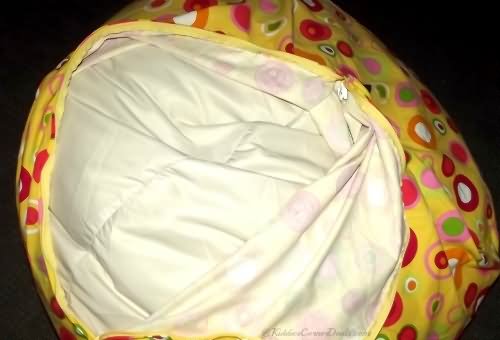 Loading... Please wait...
Loading... Please wait...- Home
- AHH Bean Bag Chair Blog
- Natural First Aid Treatment for Poison Ivy Oak: Baking Soda to Washable Bean Bag Chairs to Vinegar
Shop Now
Natural First Aid Treatments for Poison Ivy Oak: Baking Soda to Vinegar to Washable Bean Bag Chairs
Posted July 11, 2013
In my last article, Natural First Aid Treatments for Sunburn, I wrote about some easy DIY ways you can ease the pain and help heal sunburns. In this post, let’s talk a bit about the dreaded poison ivy.
Summer means warm and sunny days that get longer and longer. And that means your kids will be venturing outdoors and getting into as much mischief as possible. If you live near a wooded area, that inevitably leads to a case of “Mom, this itches” – and yikes, it’s poison ivy or oak rash. Actually, we live in a subdivision where the builder cut down most of the mature trees and only left a few patches of sparsely wooded areas (tree saves), and even in these small spaces I’ve seen tons of poison ivy growing (or is it poison oak?).
Let’s discuss what poison ivy and what poison oak is.
“Leaves of three, let it be”
“Berries white, run in fright”
“Hairy vine, no friend of mine”
Both Poison Ivy and Poison Oak:
• Found in almost everywhere in the U.S.A.
• Grows as a bush or vine
• No thorns
• Usually have 3-leaf clusters
• Leaves can be green to orange to maroon
• Small white flowers which turn into small white berries that turn red towards the end of summer
• Make an oil called Urushiol (that's what we are allergic to)
• Toxic to humans but harmless to animals (so your dog can run around the house with the oil on his fur and not have any problems, but can spread the oil on you and around your home causing you big problems!)
• Leaves, stems, and roots all have the oil!

Poison Ivy Leaves

Poison Ivy Vine
Specific to poison ivy:
• Hairy or fuzzy vines
• Looks like ivy vines
• Almond shaped leaves that can be smooth or have a slightly toothed/jagged border

Poison Oak Leaves

Poison Oak Leaf Color
Specific to poison oak:
• Leaves look like oak leaves
• Leaves are dull green and have a more toothy or scalloped border
• Mature leaves are ususally more dull green than younger leaves
• Leaves are hairy on top and underneath
**Even a slight brush against either of these plants can cause the contact dermatitis reaction because of their oils. The toxin is easily transferred from one surface to another and can actually stay active for years if not washed completely!
The itch, rash can take 24-48 hours or even up to a week to show up, which is especially true if it's the first time you have ever had it!
So if you little one (or anyone) runs into the house complaining of a red, itchy rash, don't freak out...but DO ACT IMMEDIATELY!
What natural first aid remedies can you reach for that you have in your home already to treat poison ivy or oak...?
• lots of cool water
• regular soap and shampoo
• apple cider vinegar
• baking soda
• oatmeal
• calendula cream
• calamine lotion (you can make this at home too)
• washable bean bag chair (this is the calm-down part of the treatment! Try one from Ahh! Products, where all bean bags have washable, removable covers.)
1. The very first step is to wash, wash, wash! You need to get off the plant oils from both skin and clothing as soon as possible. I don’t recommend a bath, just because I think that bathing in water filled with the oil is counter-intuitive. I prefer to stick my child in the shower and wash her from head to toe. This way, if the oil was spread to other parts of the body by their little hands, I can get it all. Just because an area of skin wasn’t exposed (covered by clothing for example) doesn’t mean you can assume the oils didn’t reach it. For older kids and other family members, make sure they understand to wash themselves off well.
You don’t have to use any kind of special soap or shampoo, just be sure it cleans oils well and be sure get every spot. I just use our regular products, which happens to be organic shampoo from Desert Essence and I love Yardley’s Oatmeal and Almond soap bars (at $1.29 for a full-size bar, it’s a great deal, smells great, and even has little exfoliating particles embedded in it).
2. After the thorough washing, make a paste of ½ cup cool water and ½ cup baking soda. You can make more if you have a lot of skin to cover (or less, just make it equal parts). Baking soda is a natural antiseptic that will help make the inflamed rash-y skin feel better.
You can also use ½ cup cool water and ½ cup apple cider vinegar (also an antiseptic). Mix it up and use a sponge to apply to the affected skin. I find the baking soda paste is better, but messier if you have to spread a lot of it on. I think it helps psychologically to see a helpful paste covering the hot spots. And, of course, the vinegar smells like vinegar!
3. After all the oil is washed off, you can do soothing oatmeal baths to cool and calm the itch. The cooler the bath, the better it will feel. You can buy oatmeal bath packets (like Aveeno), or you can grind up oatmeal into a powder yourself. Mix the powder in the bath water well to get out clumps - I pour it under running water like I do with bubble bath. Try adding ½ cup of either the baking soda or the vinegar to the bath for full-body antiseptic help. Not a cure, but a nice temporary relief.
4. You also need to wash all the clothing to get rid of any poison ivy/ oak oil. Just use your regular detergent. You should be able to wash them with your other clothing, but I don’t just to be extra cautious. If you suspect anything else was exposed to the oil, wash that too. This is when you realize why a removable slipcover on furniture is so important! And that washable bean bag cover or washable couch slipcover suddenly becomes worthy more than its weight in gold! Wipe down anything that you cannot wash in the machine with a good oil-removing soap.
5. Apply a topical. As for putting ointments or creams on the skin, I caution you about using anything with cortisone in it, especially if there are large areas to cover. Cortisone can be too strong for kids, even over-the-counter ones.
You can use a more natural calendula cream, like this one.
You can also try calamine lotion, but if the rash is bad, this doesn't help as much. There are recipes for homemade calamine lotion everywhere on the internet, but it's probably just easier to buy it and have it on hand when you need it. The homemade ones have a shorter shelf-life as well I believe.
6. Once all the washing, soothing baths, and lotion-ing up is complete, let your child just chill out in a comfortable bean bag chair. Make sure it has a washable cover, because you’ll definitely need to clean all the creams and pastes off!

Ahhprods.com Bean Bags have Washable Covers
**You need to take your child to a doctor if…the rash and itch isn’t improving after three days of your home treatment, go see the doctor right away. If the skin looks swollen or there is pain (versus itching), that might mean infection so go to the doctor! If the rash is close to eyes or mouth or inside the nose, go see the doctor. He will be able to treat with a stronger remedy and monitor healing.
Stay tuned for Part 3 – Bug Bites… Boo!
Have you used these or other natural home poison ivy treatments? Did they work for you and how well did they work? What were the pros and cons? I’d love to learn from your experiences!
Yours truly, Jade
.











